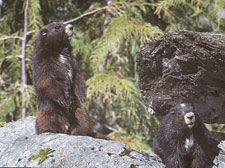ANDREW A. BRYANT,
Scientific Advisor
Marmot Recovery Foundation
As the ski-season begins on Mount Washington, I’d wager that I’m not alone in thinking about alpine competitions.
Giant slalom, Nordic, freestyle…take your pick. But I have to say, my candidate for gold medalist has already been awarded. Her name is Shelby. Having broken several records this past summer, right now she’s tucked snug in her underground burrow near the Quad chair.
You see, Shelby is a Vancouver Island marmot, one of the rarest creatures in the world. She had pups this June, becoming the first female known to have sired four litters of pups in the wild. In fact, she first bred as a two-year-old, which is very rare, and bred in four of the past five summers, which is unheard of. Hence my nomination for gold.
Her record-breaking performance amounts to very good news for North America’s rarest mammal. As their name suggests, the Vancouver Island marmot (scientists know this species as Marmota vancouverensis) lives only on Vancouver Island. The wild population of this critically endangered species is currently believed to contain about 65 individuals. That would be a very depressing statement, were it not for the fact that that number is about twice what it was only a few short years ago. As recently as 2001, this engaging and highly social ground squirrel tottered on the brink of extinction, with a wild population of about 30 individuals.
The Marmot Recovery Foundationbegan a captive-breeding program literally at the eleventh hour, in 1997. This program has been highly successful to date æ currently there are 143 marmots in captivity at the Toronto Zoo, the Calgary Zoo, Mountain View Conservation Society, and the breeding facility located here on land generously provided by Mount Washington Alpine Resort. This past year was especially successful, with a record number of 56 pups born in captivity! Perhaps more significantly, a total of 31 animals were released to the wild this past summer. Ultimately, marmots have been successfully returned to five mountains at which local extinction occurred during the late 1990s.
How are the released marmots doing? In general we’ve learned that marmots released in previous years are behaving just as wild-born marmots do, eating grasses and flowers, digging burrows and hibernating in appropriate places. In what is perhaps the most gratifying result of all, two captive-born marmots (named Haida and Onslo) that were released in 2004 also had a litter of pups this summer, becoming the first pair to complete the process of becoming truly wild marmots again and perpetuating the cycle of life.
The prognosis remains very hopeful. The Team plans to release upwards of 35-40 marmots next summer, hopefully including some to nearby Strathcona Provincial Park. It will take many more years of effort, of course, to achieve the recovery goal of a self-sustaining wild population of 400-600 marmots. Which is why your ongoing support is so critical.
So as you watch this winter’s other alpine events, I hope you will take a moment to think of Shelby and her relatives, who are engaged in the most important competition of all…avoiding the permanence of extinction.
To learn more about Vancouver Island marmots, please visit our website at www.marmots.org or visit the Marmot’s Den, which is located on the ground floor of the main day lodge.
Photos: Andrew A. Bryant
